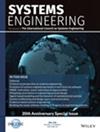A comparative experiment between textual requirements and model‐based requirements on proxies for contractual safety
IF 1.6
3区 工程技术
Q4 ENGINEERING, INDUSTRIAL
引用次数: 0
Abstract
Requirements form the backbone of contracting in acquisition programs. Requirements define the problem boundaries within which contractors try to find acceptable solutions (design systems). At the same time, requirements are the criteria by which a customer measures the extent that their contract has been fulfilled by the supplier. In this context, the quality of a requirement set is determined by the level of contractual safety that it yields. Unfortunately, textual requirements do not provide acceptable levels of contractual safety, as they remain a major source of problems in acquisition programs. Model‐based requirements have been proposed as an alternative to textual requirements, although this promise has not been demonstrated yet. This paper addresses the main question of whether using model‐based requirements improves the contractual safety of acquisition programs compared to using textual requirements. The level of adequate applicability, bounding, necessity, and completeness achieved by model‐based requirements are empirically measured using an experimental study with aerospace engineering and industrial and systems engineering students on a space system application. The results show that model‐based requirements outperform textual requirements in these four variables.文本要求与基于模型的合同安全代理要求的比较实验
需求构成了采办项目合同的支柱。需求定义了问题的边界,承包商试图在其中找到可接受的解决方案(设计系统)。同时,需求是顾客衡量供方履行合同程度的标准。在这种情况下,需求集的质量是由它产生的契约安全级别决定的。不幸的是,文本要求不能提供可接受的合同安全水平,因为它们仍然是采购计划中问题的主要来源。基于模型的需求已被提议作为文本需求的替代方案,尽管这一承诺尚未得到证实。本文解决的主要问题是,与使用文本需求相比,使用基于模型的需求是否能提高采购计划的合同安全性。通过对航天工程、工业和系统工程专业的学生进行空间系统应用的实验研究,对基于模型的需求所达到的适当适用性、边界、必要性和完整性水平进行了经验性测量。结果表明,基于模型的需求在这四个变量中优于文本需求。
本文章由计算机程序翻译,如有差异,请以英文原文为准。
求助全文
约1分钟内获得全文
求助全文
来源期刊

Systems Engineering
工程技术-工程:工业
CiteScore
5.10
自引率
20.00%
发文量
0
审稿时长
6 months
期刊介绍:
Systems Engineering is a discipline whose responsibility it is to create and operate technologically enabled systems that satisfy stakeholder needs throughout their life cycle. Systems engineers reduce ambiguity by clearly defining stakeholder needs and customer requirements, they focus creativity by developing a system’s architecture and design and they manage the system’s complexity over time. Considerations taken into account by systems engineers include, among others, quality, cost and schedule, risk and opportunity under uncertainty, manufacturing and realization, performance and safety during operations, training and support, as well as disposal and recycling at the end of life. The journal welcomes original submissions in the field of Systems Engineering as defined above, but also encourages contributions that take an even broader perspective including the design and operation of systems-of-systems, the application of Systems Engineering to enterprises and complex socio-technical systems, the identification, selection and development of systems engineers as well as the evolution of systems and systems-of-systems over their entire lifecycle.
Systems Engineering integrates all the disciplines and specialty groups into a coordinated team effort forming a structured development process that proceeds from concept to realization to operation. Increasingly important topics in Systems Engineering include the role of executable languages and models of systems, the concurrent use of physical and virtual prototyping, as well as the deployment of agile processes. Systems Engineering considers both the business and the technical needs of all stakeholders with the goal of providing a quality product that meets the user needs. Systems Engineering may be applied not only to products and services in the private sector but also to public infrastructures and socio-technical systems whose precise boundaries are often challenging to define.
 求助内容:
求助内容: 应助结果提醒方式:
应助结果提醒方式:


